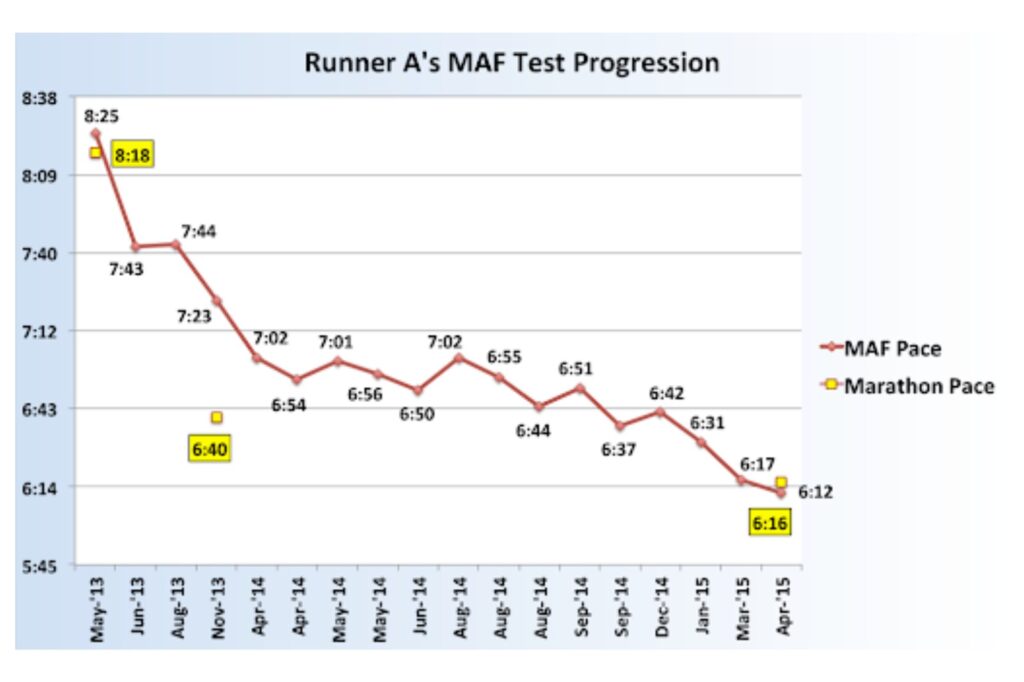
Introduction to Heart Rate Training, Part 1 of 5
Runners of all ages and abilities
Floris Gierman, host of The Extramilest Podcast, co-founder of Path Projects, and long-time MAF enthusiast
This is part one of a five-part series on heart rate training, written by Floris Gierman, co-founder of run apparel brand PATH Projects, host of the Extramilest podcast, and running coach. Over the last 11 years, he’s devoted his life to heart rate training and building a community of running through the MAF approach to running. Through the course of his training, he’s lowered his marathon time from over 4 hours to 2:44 and attributes his success to his focus on heart rate training and a holistic approach to his training, racing and life.
Let’s talk about heart rate training, a helpful approach to endurance training that has been gaining mainstream attention in recent years.
Some of this stuff may all seem pretty obvious, but let’s start with the basics before moving on to the bigger stuff.
Your heart rate (i.e. the number of times your heart beats in a minute), is an important indicator of how hard your body is working during physical activity. Your heart rate reflects the amount of oxygen delivered to your muscles and the effort level needed to maintain a given level of activity.

When exercising, the heart rate goes up to pump more blood and oxygen to the muscles, which is why tracking heart rate is an effective way to monitor exercise intensity. Chances are, you’ve seen this before– heart rate and heart rate zones on your fitness tracking devices correlate with intensity of workout. The harder your heart beats, the more blood it pumps, the more intense your workout.
While most of us may evaluate the benefits of a workout by judging our perceived effort (i.e. harder workouts = better fitness), heart rate training is a bit different. Instead of judging a workout on exertion, Heart Rate Training (HRT) is a way to monitor and regulate exercise intensity based solely on your individual heart rate and its level during exercise.
By tracking your heart rate, you can see in real-time how hard your body is working and make adjustments to your training intensity if needed, by slowing down or speeding up.
Heart Rate Training zones help athletes and coaches identify which energy systems and muscle fibers are being used at different exercise intensity levels. One common training system that some athletes are familiar with uses 5 zones. Zone 1 is the lowest intensity (sitting, walking on flat terrain), zone 5 is the highest intensity (sprinting all out).
The type of fuel your body uses to create energy changes when you increase your intensity. In zone 1 and 2, the main energy source used is fat. In zone 3, 4 and 5, you’re using carbohydrates as a primary fuel source.

Many runners train at a pace that is too high for their current fitness level. Their training intensity is in zone 3, 4 or 5, so they primarily use their limited supply of carbs for energy instead of stored body fat.
Heart rate training flips the script on that method, showing runners it’s okay to run slower. In fact– almost all of us are running too fast. Slowing down leads to better fitness, less injury, and faster race times in the long term. Over time, it allows you to build a healthy and sustainable relationship with running instead of the constant crash-and-burn cycle that most runners experience through too much high-intensity exercise.
For more insight into how you can calculate your training zone, see my post on Heart Rate Training: How It Works.
When I first started running, I would always run at a high intensity, trying to go fast even on the hills. My breathing would be heavy, I’d run tense and at the end of my run, I’d feel depleted of energy for the rest of the day. Also in those early days of running, my frequent injuries caused inconsistencies and frustrations in my training.
Once I learned to slow down on most of my runs, I discovered a new joy of running. My breathing was controlled, I started feeling much more relaxed during my run and noticed more of my surroundings. On my daily runs I’d noticed flowers, signs and other things I’d never seen before because I was more present in the moment. I also became more aware of the signals from my body and started noticing how sleep, nutrition and stress levels had a direct impact on my running performance and recovery. Low heart rate training helped reduce the impact on my body (and mind), my pains and niggles went away, and I was able to train consistently injury free.
There are three core components that come into play to make your heart rate training work for you: 1) training load, 2) recovery, stress management and sleep, and 3) nutrition.
Your training load is a combination of your training volume and training intensity (i.e. how much you train and how hard you train).
If your training is focused on hammering out hard, high-intensity training sessions, your training load will be much higher than when you train entirely at a low heart rate.
Many runners focus most of their attention on running. The more training load, the more miles, the harder the hard effort, the more we improve– right?
Yes and no. But mostly, no.
More training isn’t always better. What matters is how well we can recover from our workouts and make adaptations.
During the recovery phase is when the real benefits from our training sessions happen. This super compensation leads to improvements, only if our body can recover well (see the below chart).

High stress levels can block your aerobic development and running progress. More mileage and harder efforts equals more stress on the body. If you’re not balancing that out, your body will prioritize health over running improvements.
Of course, running isn’t the only stress-inducing part of our lives. Many non-elite athletes have full-time jobs and busy family lives, and if you’re reading this, there’s a good chance you fall into that camp. If your stress levels are high in your personal life, it will inevitably affect your training and performance as well. It all works together, so a high-intensity running lifestyle will bleed over into other areas of your life, and vice versa. Stress and fatigue can affect your performance in life as much as your performance in running, and it all can perpetuate a downward spiral if it’s not kept in check.
In this way, low heart rate training is a great way to train in a sustainable way that doesn’t add too much training load on your body and your mind.
Over the years my approach to recovery and sleep has changed significantly. Especially in the early days of my running journey, I’d neglect the importance of enough consistent quality sleep for my overall health and performance. There were periods where I’d sleep 5 to 6 hours a night and think: “I’m functioning fine, I don’t need more sleep, it’s a waste of time!” Sometimes on the weekends I’d try to “catch up on sleep.”
There is no such thing as catching up on sleep as a valid long term recovery strategy. 
What changed a lot for me, is when I learned that sleep and recovery are one of the most important parts of your training. That during these phases your real benefits from training happen. One week I did a sleep test where I forced myself to stay in bed for at least 8 hours, even if I’d wake up earlier.
After a few days, I started feeling like an entirely different person, with more clear thinking, faster recovery from workouts, more consistent energy throughout the day, no more hunger symptoms when waking up, etc. This was eye opening to me, since I really thought with 5 to 6 hours a night I was functioning fine.
During extremely busy and stressful periods in your life, I suggest all athletes train for mental and physical health. Not to push yourself too hard, but to be realistic and adjust your training expectations and race goals. Stress management plays an important role in improving your health and running performance.
Tools like meditation, breathwork, and journaling are powerful tools for stress management for athletes.
Most people underestimate the importance of sleep, and are not paying enough attention to it. During sleep your body repairs cells, restores energy, and releases molecules like hormones and proteins. Nerve cells reorganize, which helps healthy brain function.
Adults require 7 to 9 hours of uninterrupted sleep each night. Higher levels of stress require more rest and sleep to recover, so when you experience more mental or physical stress (training load), you should sleep longer.
Lack of consistent sleep can have many negative side effects, including an increased chance of injuries, failure of forward progress in your running, poor motor function, fatigue, weakened immune system, weight gain and insulin resistance.
We need to allow our bodies to rest and recover for running improvements to happen.
Nutrition is really the foundation for performance and recovery, and really– health in general. Your fat burning abilities and metabolism can be significantly impaired with poor food choices. Your energy levels, emotional states, body fat and weight can be directly impacted by the quality, type and quantity of foods and drinks we consume.
Until early 2013 I had never paid much attention to what I ate or drank. On an average day, I’d eat eight slices of bread, pasta, pizza, rice, potatoes, hamburgers, and very few veggies. I would also drink coffee, milk, orange juice and beer. My energy levels during the day were all over the place, so I’d drink coffee to get energy and often had some beers at night to relax. It was a bad cycle and for the most part, I felt tired and fatigued, plagued by low energy and frequent headaches.

In May of 2013, I decided to eat a lot healthier, inspired by Dr Phil Maffetone, Rich Roll and Tim Ferriss. I cut out all refined carbohydrates– no more bread, pasta, pizza, chips. etc. After this, I also cut out milk, alcohol, soda, fruit juices, most fruits, sweets, potatoes, rice and cut back coffee.
The reason for me to do this was to change my body’s metabolism to burn fat instead of glycogen. When you eat refined carbs, your body produces a hormone called insulin, which slows down fat burning. As soon as you get rid of refined carbs, it takes your body two meals before it shifts into a high fat burning metabolism. My energy levels increased, I slept much better and didn’t have fatigue headaches anymore, so this happens very quickly.
Today, my meals generally consist of veggies (e.g. spinach, broccoli, cauliflower, carrots, etc.), salads, tuna, salmon, bacon, chicken, beef, burrito bowls, guacamole, avocados, egg whites, beans, lentils, bananas, nuts, chia seeds, almond milk, coconut milk, green tea, 1-2 cups of coffee a day, and a lot of water.
Before MAF low heart rate training, all my training runs were hard. Heavy breathing, huffing and puffing and finishing a run feeling tired, depleted of energy. I’ve always enjoyed being outside in nature and moving around; however, most of my runs felt torturous without much pleasure, especially at the end.
In 2007, at the age of 25, I ran my first marathon. Like many first-time marathoners, around mile 20 (32 km), I hit the wall so hard that I thought I was going to die. I begged a stranger for a Gatorade and zombie-walked to the finish line. My marathon had a positive split by 1 hour with a finish time of 4 hours and 11 minutes. I told myself I would never run another marathon again.
After hearing about MAF training in 2013, I used Dr. Phil Maffetone’s 180 formula to calculate my MAF training zone. The 180 formula gave me the number of 180 minus my age 30 = 150. So for my runs I aimed to keep my heart rate in the 140 to 150 zone. I used a chest strap heart rate monitor and set an alarm on my watch at 150 HR. If my HR would go over 150, I’d have to slow down the running pace or take a walk break to let my HR come down. Over time, your pace should improve at the same heart rate.
On my first run, I hit my MAF HR of 150 within 30 seconds. “Wait,”–I thought to myself–”am I really that out of shape?!
Aerobically, yes. I wasn’t anywhere close to where I needed to be. And so began the long-yet-rewarding journey to true, all-around fitness.
Let me be real with you– heart rate training and MAF progress is not a magic bullet that will shore up your running fitness overnight. Like anything worth doing, it takes focus, discipline, and most importantly– time. Of course, there are always outliers. Some athletes improve aerobically faster than other athletes. This depends on a variety of factors, such as athletic background, training volume, stress levels, nutrition and recovery.
For me, after four weeks of MAF training, I started noticing my running pace at the same heart rate improved. This was a big “aha” moment for me that MAF training could actually work. Nevertheless, I was still somewhat skeptical.
But numbers don’t lie, and numbers were something I could look at as evidence that it was working. Fast forward two years, and it was clear this wasn’t a fluke. Below is an overview of my first 24 months of MAF training, with a running volume of 40 to 60 miles per week, with some peaks at 70 to 80 miles. Decent mileage, but nowhere near the volume of a lot of runners.

Being able to run faster at a lower intensity helps tremendously during endurance races.
As you can see, my MAF paces and my race times improved from a 4:11 marathon in 2007, to a 2:55 marathon in 2013, to a 2:44 marathon at the Boston Marathon in 2015. During my PB race training block, I only incorporated 6% of my running time at high intensity.
Since then, I’ve been able to maintain sub-3-hour fitness by keeping with the same training philosophy, and recently documented my journey as I talked my way through a sub-3-hour marathon on New Year’s Day.
I’ve helped hundreds of other athletes achieve their running goals through The Extramilest podcast and the coinciding MAF training program. Additionally, stay tuned for parts 2-5 of this ongoing series, which we’ll link below as they’re published.
Additional Information
The Extramilest is Floris Gierman’s holistic training program, focused on marathon running and reaching your full potential in training, racing, and life. Learn more about it at the link below.
Have something to say? Leave a Comment

As the founder of The Extramilest Show and running coach of the PB Program, Floris helps runners become stronger, healthier and happier athletes. Unsurprisingly, he loves low heart rate training. Floris likes to go on adventure runs, though with a terrible sense of direction, he often gets lost. He is also the co-founder of PATH projects. When not running, Floris enjoys laughing with his two daughters, playing pickleball with his wife and sitting in an ice bath.
More from Floris
Wonderful info, thank you. I didn’t realize the sugar aspect of the MAF approach until reading this. Maybe it’s in other articles but I’m curious about sugar on marathons. Did you still need to take any gels on those 2013-2015 marathons?
Floris does recommend taking gels during a marathon, but obviously do some test runs